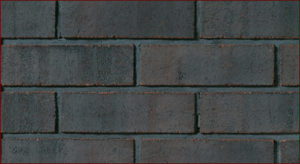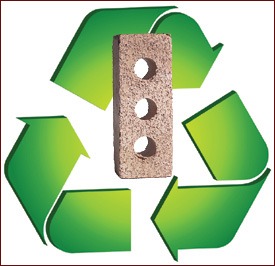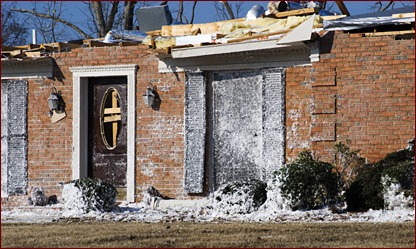Brick: Bold and Beautiful
Words: Dan Kamys
Brick
Brick stands the test of time.
By Jennie Farnsworth
[caption id="attachment_10593" align="alignright" width="300"] Hanson Brick's "Hibernia" brick is a black brick ideal for creating architectural accents on building. Coated in manganese to create its black colour, Hibernia has a leathery appearance and tiny hints of the red clay underneath. Image courtesy of Hanson Brick[/caption]
Hanson Brick's "Hibernia" brick is a black brick ideal for creating architectural accents on building. Coated in manganese to create its black colour, Hibernia has a leathery appearance and tiny hints of the red clay underneath. Image courtesy of Hanson Brick[/caption]
Over the years, members of the masonry industry have discussed options that might increase the use of brick in masonry, thereby bringing a steady flow of work to mason contractors and their crews. There's been talk of keeping masonry competitive with other systems by creating new innovations, with an overall goal of raising the market share of masonry in the U.S. building industry.
Likewise, the discriminating tastes of commercial builders and custom homebuyers are forcing brick distributors and manufacturers to broaden their product lines, search for new technologies, and keep brick at the forefront of design.
"Years ago, red brick was the traditional product of choice," says Gary Davis, VP of sales at Endicott Clay Products Co. in Fairbury, Neb. "Then, red faded out to earth tones, then grays, pastel colors, buffs and even black brick. The trends steadily change, but brick has always been there to meet those changes."
Technology betters options, decreases ecological impact
According to the Brick Industry Association (BIA), there currently are 83 brick manufacturers in the United States, operating 204 plants in 39 states. In total, these plants have the capacity to produce about 9.5 billion brick annually.
"There's a lot of new production capacity being built around the country, so I think that brick will continue to be the product of choice," Davis says. "We're in an economic downturn because of the housing situation, but we should have expected this, and it will come back. When it does, there will be a tremendous supply of brick available."
Many of these plants have the latest technologies to deliver a wider variety of brick sizes, new textures and more vibrant colors. Computerized machines can create rolled edges, dents, tumbling and other markings to produce an "aged" look. Technology has also created a much higher dimensional consistency from unit to unit that, down the line, enables masons to more quickly and accurately lay brick at the wall.
Technology has also played a role in creating more options for masonry projects. Architects have a spectrum of brick types, including thin, hollow, ceramic glazed, large core and mortarless brick, to create designs specific to regional area, financial budget, seismic codes and load requirements.
The industry's technological advances have also helped to lessen its environmental impact. More efficient energy usage in the plants, such as exhausting the heat from the turbines into the kilns, reduces energy consumption and lowers manufacturing costs.
According to the BIA, the industry energy consumption currently averages 1,239 BTU per pound [British Thermal Unit is the amount of heat required to raise the temperature of 1 pound of water by one degree Fahrenheit]. This average is less than that of its competitors: concrete, glass, steel, aluminum and wood.
"In terms of brick masonry, the industry has reduced the amount of energy that we use to manufacture brick by at least half over the last 25 years," says Patrick Kelly, masonry systems manager for Hanson Brick and Tile, with U.S. headquarters in Charlotte, N.C. "In terms of emissions, as new plants and technologies come about, the whole industry is becoming much more environmentally friendly."
Green brick
[caption id="attachment_10594" align="alignright" width="275"] © Photographer: Raja Rc | Agency: Dreamstime.com[/caption]
Nowadays, ecological awareness and LEED construction go hand-in-hand. The Leadership in Energy and Environmental Design (LEED) Green Building Rating System was developed by the U.S. Green Building Council (USGBC) as a national program to define and measure what constitutes a "green" building. The goals of the LEED certification process are to improve environmental performance and economic returns of buildings. Buildings are LEED certified if they achieve at least 26 points out of a possible 69.
© Photographer: Raja Rc | Agency: Dreamstime.com[/caption]
Nowadays, ecological awareness and LEED construction go hand-in-hand. The Leadership in Energy and Environmental Design (LEED) Green Building Rating System was developed by the U.S. Green Building Council (USGBC) as a national program to define and measure what constitutes a "green" building. The goals of the LEED certification process are to improve environmental performance and economic returns of buildings. Buildings are LEED certified if they achieve at least 26 points out of a possible 69.
When it comes to pairing brick masonry with LEED, brick's lifecycle expectancy, local or regional manufacturing, and thermal mass make this construction medium a perfect fit for sustainable construction. By design, brick masonry is an ecological dream: The raw materials in brick are chemically inert and, therefore, will not contribute to indoor air pollution; brick is fire resistant and offers insulating benefits; brick's thermal mass absorbs and stores heat until it is needed; and recent studies indicate that brick homes lower heating and cooling costs by up to 8 percent when compared to homes clad in vinyl.
Additionally, brick not only can be manufactured to contain post-industrial recycled content, but also it is highly recyclable. With areas like Chicago that now require 50 percent of construction and demolition waste to be recycled for building permits issued in 2008, a material's ability to be recycled will certainly come in as a major factor for builders and owners.
Currently, brick structures can potentially receive LEED points for storm water management, energy performance, reuse and waste management, use of regional materials and heat island effect reduction. A push to include a "durability" category that would include lifecycle assessment exists, which would also go far to separate brick from other materials in the eyes of LEED architects and other green aficionados.
"When you look at the long life of a building, such as with lifecycle assessment, masonry starts to play a bigger role," Kelly says. "If you look back into history, masonry has been around for thousands of years, and that's very important to sustainability.
"I believe the LEED focus is going to change a bit toward lifecycle assessment, and that will favor masonry materials, such as brick," he says.
[caption id="attachment_10595" align="alignleft" width="416"] After a hurricane ripped through a Columbus, Ga., neighborhood, the brick walls of this home were left standing. © Photographer: Laura Clay-ballard | Agency: Dreamstime.com[/caption]
After a hurricane ripped through a Columbus, Ga., neighborhood, the brick walls of this home were left standing. © Photographer: Laura Clay-ballard | Agency: Dreamstime.com[/caption]
Strength and versatility
Since 2000, the U.S. insurance industry has paid out more than $39 billion to cover damage caused by hurricanes, tornados and other natural disasters, according to the BIA. This figure represents more than 50 percent of the combined payouts for all catastrophic events in the preceding 30 years. The 2005 hurricane season, in particular, prompted more commercial and residential homeowners to reevaluate the materials they use for construction.
Wind and water are often the leading cause for damage during catastrophic natural events. According to Risk Management Solutions, a leader in quantification and management of catastrophe risk, wind-related damage alone exceeds $70 billion at a 100-year return period. However, time and time again, brick masonry has proven itself to be a worthy adversary to these natural foes.
The BIA funded research at the Wind Science and Engineering Research Center at Texas Tech University, demonstrating that clay brick cladding provides increased defense against wind-blown debris when compared to other siding materials. In the tests, engineers fired a 7.5-foot-long, 9-pound 2X4 at a brick veneer wall at 34 mph. It bounced off the brick, causing no damage to the interior wall. A 2X4 fired at the same speed penetrated a vinyl or fiber-cement sided wall by more than five feet, piercing the interior wall. The test was representative of weather that would generate wind speeds between 100 and 140 mph.
Architects explore brick design
While lifecycle assessment, durability, safety and environmental impact should be clear-cut arguments to use brick, architects have the added requirement for creative and attractive materials. Brick easily meets these standards.
With its varying degrees of colors, textures, shapes and sizes, brick allows city planners to create an underlying theme of long-lasting, valuable and quality masonry construction for an area, while creating distinguished character from one building to another.
"Among the trends and innovations in clay brick is the idea that 'old is new,'" says Kathleen Jonila, director of marketing for Hanson Brick and Tile. "Many builders and homeowners are seeking to create old, historic or weathered looks in new buildings, particularly in areas with infill building or growth in already developed cities."
[caption id="attachment_10590" align="alignright" width="300"] Hanson Brick's Glenhaven is one of a dozen new earth tone bricks introduced into the Texas market at the start of 2008. Image courtesy of Hanson Brick[/caption]
Hanson Brick's Glenhaven is one of a dozen new earth tone bricks introduced into the Texas market at the start of 2008. Image courtesy of Hanson Brick[/caption]
Also, a growing trend toward town centers as the focal point of densely constructed urban residential areas shows strong favoritism toward the use of brick commercial construction. And, in newer areas, brick construction often begets brick construction when it comes to newer neighborhoods, when large retail areas built with the newest brick design set the trend for smaller commercial and residential construction, or vice versa.
Across the nation, a growing understanding among designers concerning the various design capabilities that brick architecture brings to the table is evolving. As they are seeing their peers play with brick positioning, bond patterns, different mortar joints and colors, façade textures, accent pieces, bands, arches, corbelling, recesses and projections, designers are beginning to aspire to the same creative expression with this quality construction medium.
"We try to educate architects and designers," Davis says. "Unfortunately, they don't always get that type of training at the university level as much as we would like. When they get out into the field with their architectural firm, they usually become aware of brick's capabilities and what's available to them.
Kelly adds, "We need to promote brick masonry. I think a lot of people take masonry too much for granted, and don't promote the positive attributes enough."
Side Story: